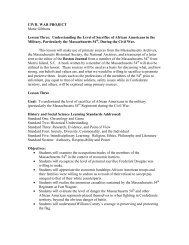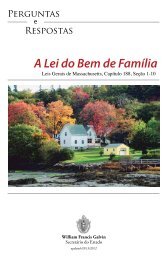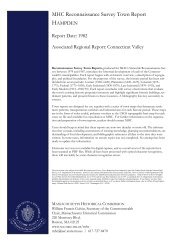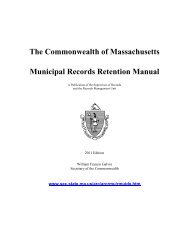Roads, Rails, and Trails - Secretary of the Commonwealth
Roads, Rails, and Trails - Secretary of the Commonwealth
Roads, Rails, and Trails - Secretary of the Commonwealth
Create successful ePaper yourself
Turn your PDF publications into a flip-book with our unique Google optimized e-Paper software.
THE BIG DIG SITES, BOSTON<br />
No book about transportation in Massachusetts could be<br />
complete without some mention <strong>of</strong> <strong>the</strong> Big Dig. And no book<br />
about Massachusetts archaeology would be complete without<br />
mention <strong>of</strong> <strong>the</strong> archaeological studies that were done in<br />
advance <strong>of</strong> that massive undertaking. As anyone who has lived<br />
in <strong>the</strong> Boston area for <strong>the</strong> past decade or so well knows, <strong>the</strong> Big<br />
Dig (<strong>the</strong> burying <strong>of</strong> <strong>the</strong> Central Artery in Boston) is <strong>the</strong> largest,<br />
most complex, <strong>and</strong> in many ways <strong>the</strong> most innovative road<br />
construction project ever completed. Before <strong>the</strong> construction<br />
began, though, <strong>the</strong>re were a series <strong>of</strong> archaeological digs in<br />
Boston <strong>and</strong> Charlestown. Not only did archaeologists probe <strong>the</strong><br />
areas within <strong>the</strong> planned route <strong>of</strong> <strong>the</strong> new underground<br />
highway, <strong>the</strong>y also studied areas that would be indirectly<br />
impacted by <strong>the</strong> project, like Spectacle Isl<strong>and</strong> in Boston<br />
Harbor, where material excavated for <strong>the</strong> tunnels was to be<br />
placed.<br />
Boston, Massachusetts<br />
51<br />
The results were beyond anyone's expectations. The<br />
information from <strong>the</strong> Big Dig archaeology changed <strong>and</strong><br />
deepened our underst<strong>and</strong>ing <strong>of</strong> Boston's ancient, colonial, <strong>and</strong><br />
industrial past. Sites that were discovered <strong>and</strong> excavated<br />
included ancient Native American settlements on Spectacle<br />
Isl<strong>and</strong> <strong>and</strong> in Charlestown on what was <strong>the</strong> water's edge<br />
thous<strong>and</strong>s <strong>of</strong> years ago when sea levels were lower. Also in<br />
Charlestown, archaeologists discovered <strong>the</strong> site <strong>of</strong> <strong>the</strong> home <strong>of</strong><br />
Massachusetts' first governor, John Winthrop, <strong>and</strong> <strong>the</strong> Three<br />
Cranes Tavern, an establishment that opened in 1635 <strong>and</strong> lasted<br />
for 140 years, until it was burned in <strong>the</strong> aftermath <strong>of</strong> <strong>the</strong> Battle<br />
<strong>of</strong> Bunker Hill.<br />
Excavation <strong>of</strong> <strong>the</strong> Three Cranes Tavern site in Charlestown.








